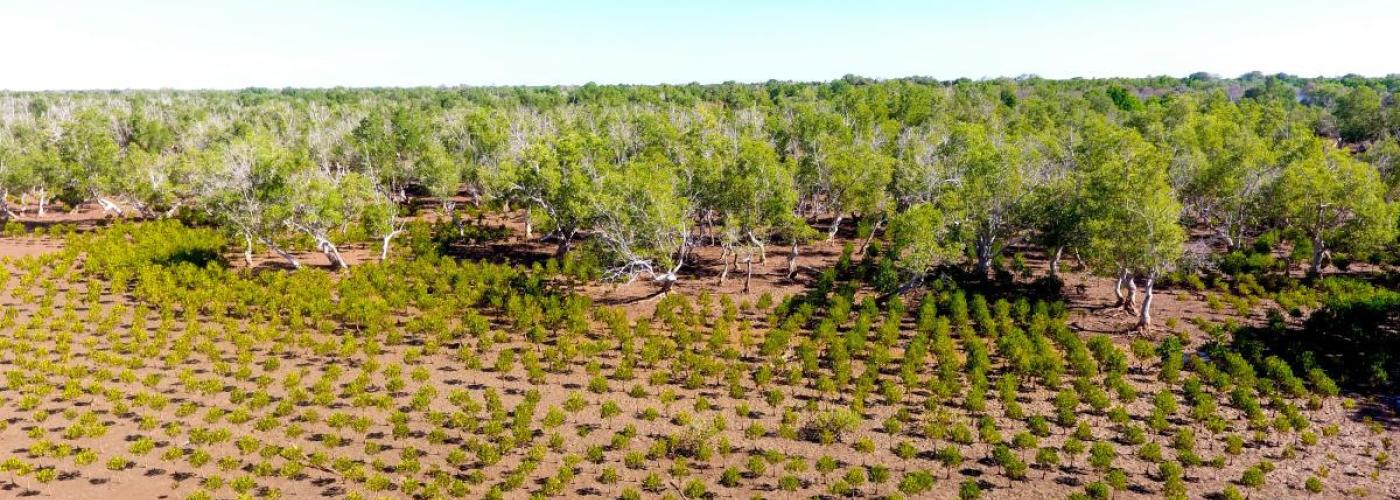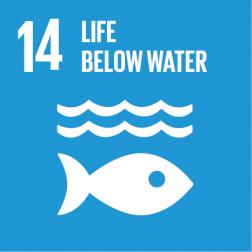There are no mangroves in Europe, but they are all the more plentiful in tropical and subtropical regions of the world. A total area of just under 150,000 km² of mangroves is thought to remain, that’s 5 times the size of Belgium. One-fifth of the world's mangroves are in Indonesia.
Such beach or tidal forests, as they are also sometimes called, are often found along silt-rich low sea coasts in tropical or subtropical areas. Mangrove trees and shrubs have distinctive, somewhat erratic aerial roots and are perfectly adapted to a saline environment.
Carbon storage and biodiversity
The role played by mangrove trees and shrubs is very diverse and extremely important for the entire planet. One of the reasons for this is that they harbour enormous biodiversity. Fish find an ideal sheltered spawning ground there, but shellfish, birds, insects and mammals also feel at home. Mangroves are also home to certain iconic species such as the red ibis in South America and the endangered white-tailed eagle in Madagascar. Mangroves also offer a wealth of medicinal plants.
They also store massive amounts of carbon, making them a crucial weapon in the effort to combat climate disruption and its impacts. In addition, they protect the coast from erosion and extreme weather events such as storms or tsunamis that may become more frequent as a result of the changing climate. They also improve water quality by filtering out pollutants.

Large parts of Madagascar's mangroves have been cut down. © Louvain Coopération
At least 40% of the world's mangroves have disappeared
Despite the measures already undertaken, tidal forests are still being lost today. According to UNESCO, 40 percent of tidal forests are said to have disappeared between 1980 and 2005, mainly as a result of coastal development. The same is also true on Madagascar, a large island off Mozambique in the Indian Ocean. In the west of the island in particular, 3000 to 4000 km² of coasts are still covered with beach forests. But in the past 23 years, as much as 25% of those mangroves are said to have been destroyed.
The destruction in Madagascar is mainly related to climate change and population pressure. The south of the island is repeatedly affected by severe drought. Residents there have no other choice but to migrate to the coasts. There, they cut down the mangrove forests to create agricultural land. They use the wood for cooking and to build their homes and for making boats known as praus. Large companies are starting to cultivate rice and grow shrimp there.
Without mangroves there would be no fish
At the same time, Madagascar relies heavily on fishing. And those who cut down mangroves are also decimating the spawning grounds of fish. In other words, the loss of mangroves undermines the future of fishermen because fewer and fewer fish can still reproduce.
The Belgian NGO, Louvain Coopération – a partner of Belgian Development Cooperation and affiliated with UCLouvain – has been trying to turn the tide in Madagascar since 2006. Indeed, the NGO determined that it could not possibly help fishermen move forward if the mangroves continued to disappear. That is why it is now working with the population of the Menabe region to plant new mangroves or restore damaged sections.
This is proving a success! Between 2017 and 2021 alone, Louvain Coopération managed to replant 180 hectares of mangrove. In order to achieve that, 482,000 mangrove fruits were planted and 2,630 residents received awareness training about the need to protect natural resources.
_KL.jpg)
Local people are very closely involved in the mangroves' restoration. © Louvain Coopération
The local population is closely involved
Ensuring local people are closely involved is overwhelmingly the key to the project's success. Everything is done in consultation with the residents and they also play an active part. For example, they collect and triage the fruits and then plant them at low tide. The knowledge of certain elderly people is also being put to good use.
The coast and the sea are essential to the livelihood of much of the population. It was therefore never the intention to completely seal off portions of the mangroves as a nature reserve and take them out of use. However, it was decided, together with the population, to cease fishing in certain areas for several months. This will give the fish a chance to spawn and provide offspring without being disturbed.
Local traditions are also respected and local chefs are closely involved. The local authorities also receive support in order to manage the mangroves and monitor the protected areas.
Fishing cooperatives were taught how to process fish into value-added products. That way, the fishermen can earn more and will therefore need to cut down less wood.
Joining forces
Louvain Coopération is very satisfied with the approach. It will therefore continue carrying out this work within its new action programme for 2023-2027 – thanks to funding from the Belgian Development Cooperation. It also intends to commence activities in Benin.
Moreover, it is also joining forces with the 3 other NGOs operated by French-speaking universities: Eclosio (ULiège), FUCID (UNamur) and ULB-Coopération. These NGOs are also restoring mangroves, specifically in DR Congo, Senegal, Guinea and Togo. The collaboration should also provide an opportunity to share good practices and allow the mangroves to be protected even more effectively than before.
By protecting the mangroves, we are not only helping to advance biodiversity (SDG14), but are also supporting the livelihoods of fishermen (SDG1) as well as making a significant contribution to the combating of climate change and its impacts (SDG13).




